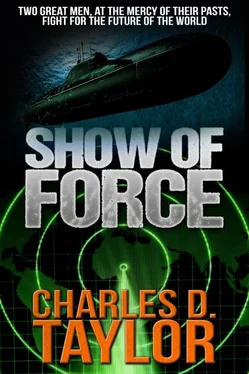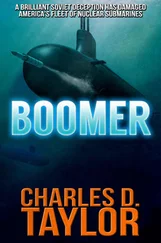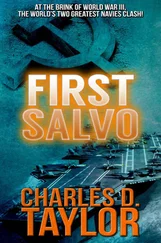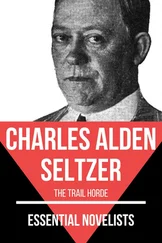"Excuse me, Admiral." Kupinsky's thoughts shifted quickly back to the signal bridge of Lenin. He straightened from the railing, turning quickly, and returned the salute of the young staff officer who had interrupted his dreams. "Sir, Captain Svedrov reports that our Rigas have inflicted heavy damage on surface units of the American forces. They left at least four ships, One of them a large cruiser, burning."
"Were any of them sunk?"
"I do not believe so, sir, although a guided-missile destroyer was severely damaged."
"And what of our own casualties?"
The young man hesitated. "The American missile system was very accurate, Admiral. Three of our Rigas escaped, only to be set upon by fighter aircraft." His voice dropped almost to a whisper. "Only one is returning, sir."
"I see."
"Also, he wishes me to inform you that the American attack aircraft are only ten minutes away. We have sent our helicopters south to assist the destroyers with the approaching submarines. He respectfully asks if you will join him and the staff shortly."
"Yes. Inform Mr. Svedrov I will be down in a few moments." The young man saluted, then wheeled about to carry his message, even before Kupinsky had returned the salute. He hated the idea of going down into the dark flag plot where he could see nothing of the action taking place. It was simply moving dots on screens with no size or shape or animation. He would have much preferred to be on the signal bridge watching the effect of the various weapons. But he realized that most of the action would take place beyond his eyesight anyway, and they needed him to coordinate the action once they had initiated his battle plan.
Plot in Lenin was similar to that in Nimitz. It was a bit smaller, since the Russians often sacrificed human space for weapon space, but it performed essentially the same functions. Many of the weapons were different, yet they had been devised for the same purposes. As Alex entered the room to assume his position next to Captain Svedrov, his Chief of Staff, he quickly reviewed the status of operations. He saw the flight of A-7's approaching his force, the American submarines to the south, and in another corner of the room, a board showing the dispersed American force.
As he seated himself, Svedrov reported, "All ships have expanded the screen in preparation for any nuclear attack, sir. Our computers indicate that the American planes are not armed with atomic weapons at this time, but I felt it better not to take any chances. We have already dispersed high-level chaff to counter their missile radar, and our escorts are radiating large-ship signals. I doubt they will be able to select Lenin unless they are willing to come within visual range."
"The lead aircraft will fire Harpoon missiles, and that should be any minute now. Their range is over fifty miles," remarked Kupinsky. "Once those are locked onto a target, they will then send the secondary flight in with their Bullpup missiles. Do not let anyone be fooled when those first aircraft turn back after firing. I know that is just what David Charles would like to see."
"Who, Admiral?"
"Admiral Charles, their commander. He believes quite strongly in the dual-strike method." Svedrov looked quizzically at his commander. "I know the man well v Svedrov. Remember my explanation of the other day? He is a brilliant commander. I can also assure you that his submarines are maneuvering to position now to fire at about the same time as those aircraft."
It didn't happen exactly the way that Admiral Kupinsky predicted, but it was close enough to satisfy his staff. The submarines anticipated the A-7's by just half a minute, but David Charles had expected that would be possible. All of his fleet units were instructed to act independently when they were going into action, unless they were tied into the master computer. In this case, he wanted his commanders to shoot when they were in the best position.
While Dallas sped off underwater to the east to draw off some of the helicopters, the captain of Mendel Rivers simply went full ahead for a few moments, directly toward the center of the Russian force. It was relatively easy to evade the helos in the vicinity for long enough to confirm a solution in the computer and fire the Harpoon missiles. The formation had been adequately plotted by satellite earlier in the day and Rivers' sensors were able to maintain the locations of the larger Soviet ships.
The missile broke the water approximately forty miles from the southernmost cruiser in the extended screen. After igniting and orienting itself, it raced toward the target in full view of the helos already warning of its approach. The CO of Rivers had chosen his target because of its name and importance to the Russian people. He had a perfect solution for the missile, and it was fired too close for the captain of Marshal Timoshenko to consider evading. There was no time for a solution for his own antimissile weapons, and his men vainly fired their 76- and 23-mm. guns at a missile that could barely be perceived at that speed. The ship also tried to maneuver. The explosion on impact literally ripped the stern off the 7,500-ton ship, completely destroying the after engineering spaces and detonating one of the magazines. The secondary explosion tore a hole farther forward from the main deck to well below the waterline. She was dead in the water in less than thirty seconds, the fires providing an excellent target for any aircraft that cared to finish off the long sleek cruiser, but she soon sank of her own accord.
Just moments later, as the lead aircraft from Nimitz were launching their own attack, Dallas successfully fired two missiles, one at the lead destroyer of a group of four heading in her direction, and the second at another cruiser in the rear of the formation. An instant before the missile exploded, blowing the bow off . Bodry, one of the newest destroyers in the fleet, the Russian ship fired its own antisubmarine missile, based on a quick solution in tandem with one of the helicopters. The missile from the fated destroyer did not land in the water as close to Dallas as it had been planned, but that was of no help to the American boat. The torpedo carried by that missile locked on to its target immediately. Seconds before Dallas's pressure hull was shattered, each man heard the whine of the high-speed propellers overtaking their boat. The destroyer, racing forward at thirty-two knots, ripped itself apart. With no bow, its weak interior bulkheads collapsed from the forward motion. The second missile from Dallas removed the bridge and the three top levels from the giant cruiser Nikolayev, named after the yard that had built so many of the ships in that task force. Nikolayev was also a target of the air attack. Just as she regained control in after steering, with her executive officer now in command, two more missiles hit, one amidship at the waterline, destroying main control, and the second in a torpedo magazine. The dual explosion, and the water rapidly filling the starboard side, rolled Nikolayev onto her beam. Secondary explosions completed the job, and she turned turtle.
As far as Admiral Kupinsky was concerned from his position in flag plot, the exchange was weighing in favor of the Americans. While the latter did not have as strong a defense against airborne missiles as his own force, he decided — that his own antisubmarine protection was not as effective as it appeared on paper. Though their ships carried enough weapons to sink each American sub three or four times, they had to catch them first, and the rapid acceleration of a nuclear attack boat easily confused his own helicopters. He needed the long-range standoff capability to fire on the subs before they fired on him. The loss of one cruiser and one destroyer convinced him that it was time to send his ASW units away from Lenin to keep the subs at a distance. He would have credited Dallas with a second cruiser, but that had actually been finished off by the Americans' planes.
Читать дальше












